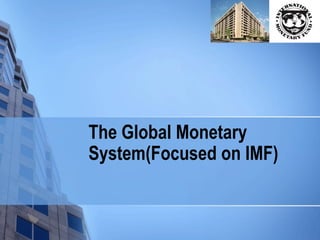Imf ppt
- 1. Welcome To Presentation Presented by: Sabiha Sultana Chowdhury ID:13045
- 2. The Global Monetary System(Focused on IMF)
- 3. Topics ÔÅÆ Introduction ÔÅÆ The gold standard ÔÅÆ Exchange Rate Regims,End of 2001 ÔÅÆ Role of Monetary Fund ÔÅÆ Summary ÔÅÆ Conclusion and Recomendation
- 4. What is IMF(International Monetary Fund)? The IMF is an international organization of 185 member countries. It was established to promote international monetary cooperation, exchange stability, and orderly exchange arrangements; to foster economic growth and high levels of employment; and to provide temporary financial assistance to countries to help ease balance of payments adjustments.
- 5. Why was it created? • The IMF was conceived in July 1944, when representatives of 45 governments meeting in the town of Bretton Woods, New Hampshire, in the northeastern United States, agreed on a framework for international economic cooperation.
- 6. The Gold Standard:  Pegging currencies to gold and guaranteeing convertibility is known as the gold standard.  By 1880, most of the world's major trading nations, including Great Britain, Germany, Japan, and the United States, had adopted the gold standard.  For example, under the gold standard, $1=23.22grains of “fine” (pure) gold. Thus, one could, in theory, demand that the U.S. government convert that one dollar into 23.22 grains of gold. The amount of a currency needed to purchase one ounce of gold was referred to as the gold par value. From the gold par values of pounds and dollars, we can calculate what the exchange rate was for converting pounds into dollars; it was £.60 = $1 (current exchange rate)  The great strength claimed for the gold standard was that it contained a powerful mechanism for achieving balance-of-trade equilibrium by all countries.
- 7. Exchange Rate Regims IMF Members Exchange Rate Policies,2002
- 8. Agenda ÔÅÆ IMF History ÔÅÆ IMF Main Responsibilities ÔÅÆ Details of how IMF works ÔÅÆ Bangladesh and IMF ÔÅÆ The Future of IMF
- 9. IMF History ÔÅÆ Established at a United Nations conference in Bretton Woods, New Hampshire, in July 1944. ÔÅÆ Initially composed of 45 governments with the intention of building an economic cooperation that would help avoid economic disasters such as, the Great Depression of the 1930s. and long term direction
- 10. IMF Main Responsibilities ÔÅÆ Promoting international monetary cooperation ÔÅÆ Facilitating the expansion and balanced growth of international trade ÔÅÆ Promoting exchange stability ÔÅÆ Assisting in the establishment of a multilateral system of payments ÔÅÆ Making its resources available (under adequate safeguards) to members experiencing balance of payments difficulties
- 11. How does the IMF achieve its objectives? ÔÅÆ Surveillance: monitoring of economic and financial developments, and the provision of policy advice, aimed especially at crisis-prevention. ÔÅÆ Lending to countries with balance of payments difficulties providing temporary financing ÔÅÆ Support policies aimed at correcting the underlying problems and reduce poverty. ÔÅÆ Providing technical assistance and training in its areas of expertise. IMF work is supported by its economic research and statistics
- 13. Executive Management Selection  Managing Director position is traditionally European while the Deputy is American.  The Developing Countries complain that they have a stake in the IMF and their voting power is limited.  Voting power is proportional to a member’s contribution ( quota) which was set 50 years ago.
- 14. IMF Finances  Quota System: Each member’s quota is based on its relative size in the world economy. Upon joining the IMF, a country normally pays up to one-quarter of its quota in the form of widely accepted foreign currencies (such as the U.S. dollar, the euro, the yen, or the pound sterling) or Special Drawing Rights (SDRs). The remaining three-quarters is paid in the country's own currency.
- 15. IMF Finance cont’d  Gold holdings: Valued at current market prices, are worth about $68 billion as of March end 2007, making the Fund one of the largest official holders of gold in the world  Lending capacity: The IMF can only use its quota-funded holdings of currencies of financially strong economies to finance lending. The IMF's Executive Board selects these currencies every three months.
- 16.  Special Drawing Rights (SDR) potential claim on the freely usable currencies of International Monetary Fund members.  SDRs are defined in terms of a basket of major currencies used in international trade and finance. They are used as international reserve assets. They are proportional to a member’s quota. IMF Finance cont’d
- 17. When can a country borrow from the IMF? ÔÅÆ A member country may request IMF financial assistance if it has a balance of payments need when it cannot find sufficient financing on affordable terms to meet its net international payments. An IMF loan eases the adjustment policies and reforms that a country must make to correct its balance of payments problem and restore conditions for strong economic growth.
- 18. Current IMF facts and Statistics ÔÅÆ Current membership: 185 countries ÔÅÆ Staff: approximately 2,716 from 165 countries ÔÅÆ Total Quotas: $317 billion (as of 7/31/06) ÔÅÆ Loans outstanding: $28 billion to 74 countries, of which $6 billion to 56 on agreed terms (as of 7/31/06) ÔÅÆ Technical Assistance provided: 429.2 person years during FY2006 ÔÅÆ Surveillance consultations concluded: 128 countries during FY2006, of which 122 voluntarily published information on their consultation.
- 19. At a Glance : Bangladesh's Relations with the IMF ÔÅÆ Current IMF membership: 188 countries ÔÅÆ Bangladesh Joined on August 17, 1972; accepted the obligations under Article VIII, Sections 2, 3, and 4 on April 11, 1994. ÔÅÆ Quota: SDR 533.30 million ÔÅÆ Outstanding loans: ECF Arrangements SDR 526 million (as of June 2014). ÔÅÆ The last Article IV Executive Board Consultation was on November 27, 2013 (Country Report 13/357)
- 20. IMF’s Conditions for Loan  1991 loan for 2.5 billion SDRs  Sweeping set of reforms  Private sector freed from Govt Controls  Tighter Expenditure Policy  Price Reforms  Imports Liberalized  Market determined Exchange rate
- 21. The Future of IMF:  IMF was headed down hill after five years of inactivity, accusations of issuing poor advice, questioning of its relevance and usefulness, Facing a deficit of its own & Inability to sell its gold reserves  IMF is gaining relevance once again :  being considered to take on a sovereign wealth fund role to avoid a repeat of a global credit crisis  Increased regulation & surveillance of the financial system
- 22. Summary ÔÅÆ In an open economy, policymakers try to maintain internal and external balance. ÔÅÆ The gold standard system contains a powerful automatic mechanism for assuring external balance, the price-specie-flow mechanism. ÔÅÆ Attempts to return to the prewar gold standard after 1918 were unsuccessful. ÔÅÆ As the world economy moved into general depression after 1929, the restored gold standard fell apart and international economic integration weakened.
- 23. Summary ÔÅÆ The architects of the IMF hoped to design a fixed exchange rate system that would encourage growth in international trade. ÔÅÆ To reach internal and external balance at the same time, expenditure-switching as well as expenditure-changing policies were needed. ÔÅÆ The United States faced a unique external balance problem, the confidence problem.
- 24. Conclusion and Recommendations ÔÅÆ One Size fits all Model does not work. ÔÅÆ The interests of the G-7 Nations. ÔÅÆ Forces tighter Monetary policy (Ex Korea Interest rates > 25%). ÔÅÆ Should give equal importance to Social and Political issues.
- 25. Q and A ??? Thank you!!!
























